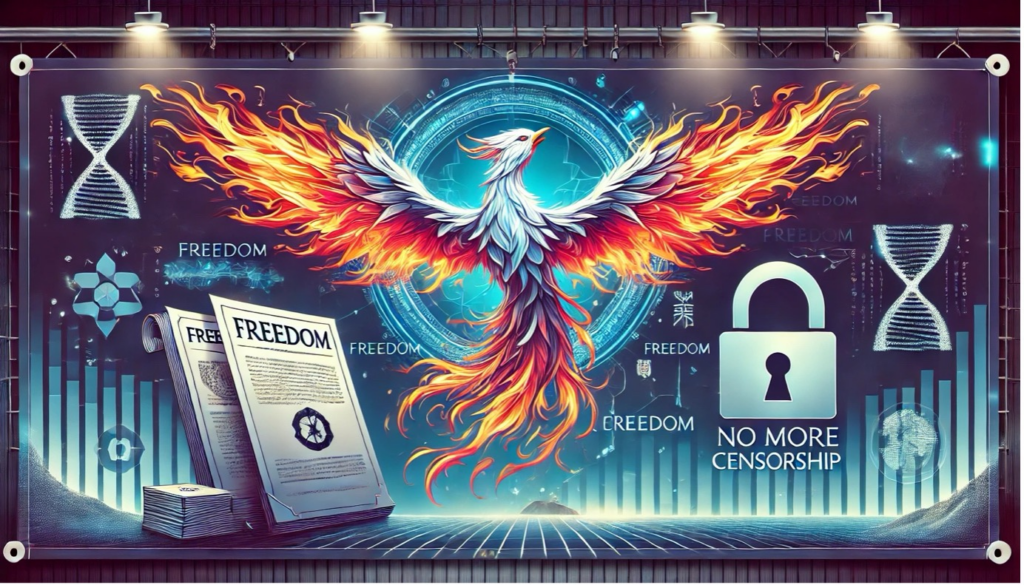
A Small Spark Can Ignite a Prairie Fire
In the information age, technology has not only transformed our way of life but has also provided new tools for social movements. When traditional media and social platforms become targets of censorship, Web3 technology is quietly emerging, offering new hope and possibilities for those who yearn for freedom of speech and social justice. The advent of blockchain technology ensures that the truth is permanently recorded and cannot be erased, allowing ordinary people to engage in resistance in unprecedented ways and ultimately change the world.
A thought-provoking example occurred during China’s #MeToo movement. When online platforms such as WeChat and Weibo swiftly deleted posts exposing Peking University’s cover-up of a sexual assault case, a public letter written by student Yue Xin faced the same fate. The government’s censorship system attempted to erase this letter, which revealed the campus scandal. However, blockchain technology became the last stronghold for these suppressed voices. Users of the Ethereum blockchain embedded Yue Xin’s letter into a transaction with zero monetary value, ensuring that the letter would exist permanently on the blockchain, accessible to anyone who browses the public ledger. This event holds historical significance, reminding us that the immutability of blockchain provides an ultimate tool to circumvent censorship.
Although, at the time, this technology had limitations in terms of widespread information dissemination, its potential is undeniable. The phrase “No 404 errors on the blockchain” aptly illustrates how Web3 technology grants suppressed voices a permanent record. This is not just a technological advancement—it is a shift in power, demonstrating that even the smallest spark can ignite a fire capable of changing the world.
Through such technology, social movements can transcend national borders and bypass censorship systems, evolving into an unstoppable global wave. Whether for resistance, human rights protection, or the fight against injustice, Web3’s decentralisation and immutability provide us with new tools and methods to drive social progress.
Although these technologies may seem distant, their influence is subtly permeating our daily lives. They symbolise every courageous voice and every unyielding soul that refuses to bow to oppression. In these challenging times, Web3 technology is like a small spark quietly spreading into a blazing fire, inspiring more people to believe that we can harness the power of technology to change the world.
A Comparison of Web1, Web2, and Web3
Throughout the development of the internet, Web1 was its earliest form, primarily characterised by “reading”. During this period, users could only passively browse content on web pages, with the internet serving a relatively simple function—mainly for information retrieval. This phase lasted roughly from the early 1990s to the early 2000s. Typical Web1 applications included early websites and personal homepages, most of which were static and did not support user interaction.
With technological advancements, the internet entered the Web2 era, defined by “writing”—meaning that users were no longer just passive consumers but could also create, edit, comment on, and share content. The rise of Web2 led to the emergence of highly interactive platforms such as social media, blogs, and forums, transforming the internet from a mere information dissemination tool into a global interactive platform. From the early 2000s to the early 2010s, Web2 was exemplified by platforms likeFacebook, Twitter, and YouTube, which allowed users to create and share content, significantly reshaping how information was distributed.
At present, we are witnessing the emergence of Web3. Unlike its predecessors, Web3 emphasises “ownership”, meaning that users are not just participants in the internet but also owners of digital assets. At its core, Web3 is built on decentralisation, ensuring that data is no longer controlled by a single central authority but is collectively maintained by all network participants. This shift is driven by blockchain technology, and Web3’s applications extend beyond finance to include decentralised applications (dApps), digital identity verification, and NFTs. The ultimate goal of Web3 is to create a more transparent and equitable internet, where users truly own their data and digital assets.
Social Mobilisation and Challenges in the Internet Era
Throughout the development of Web1 and Web2, their close connection with social movements has been particularly noteworthy. In the Web2 era, the explosion of social media enabled citizens to mobilise and collaborate in unprecedented ways, giving rise to globally influential protest movements such as the Arab Spring, the Umbrella Movement, and Occupy Wall Street. These movements benefited from the openness of the internet and the rapid dissemination capabilities of social media, allowing users to share information, organise events, and attract global attention in a short period. However, Web2 also revealed certain limitations when it came to mass mobilisation.
For instance, as governments tightened their control over digital spaces, information censorship and data removal became commonplace. In the second half of 2022, the Hong Kong government submitted 183 content removal requests to Google, particularly concerning content related to the National Security Law. At the same time, the ban on the protest song “Glory to Hong Kong” sparked concerns over freedom of speech, with some even fearing that Google might withdraw from the Hong Kong market as a result. These examples illustrate that, although the Web2 era empowered users to express themselves and organise movements, the centralised nature of platforms means they remain susceptible to government and corporate pressure, restricting the flow of information and the ability to mobilise.
In contrast, Web3 has the potential to address these issues through decentralised technology, offering a more secure and censorship-resistant platform for social movements.
For more insights into Web3’s characteristics and its application in social movements, refer to our publication: “Decentralized Archiving: A Beginner’s Guide to Web3 Preservation”!
Download (Traditional Chinese only): Click here
星星之火,可以燎原
在資訊時代,科技不僅改變了我們的生活方式,也為社會運動提供了全新的動員工具。當傳統媒體和社交平台成為審查的對象時,Web3 技術正在悄然崛起,為那些渴望言論自由和社會正義的人們提供了新的希望和可能性。區塊鏈技術的出現,讓真相有了無法被抹去的記錄,讓普通人能夠以全新的方式參與抗爭,改變世界。
一個引人深思的例子發生在中國 #MeToo 運動期間。當網絡平台如微信、微博等迅速刪除有關北京大學掩蓋性侵案件的帖文時,學生岳昕的一封公開信也面臨同樣的命運。政府的審查系統試圖將這封揭露校園醜聞的信件徹底抹去。然而,區塊鏈技術成為了這些被壓制的聲音的最後堡壘。以太坊區塊鏈的使用者將岳昕的公開信嵌入到一筆價值為零的交易中,使得這封信在區塊鏈上永久存在,任何人都可以通過公開的區塊鏈瀏覽它。這件事件具有一定的歷史意義,它提醒我們,區塊鏈的不可篡改特性,讓我們擁有了一個規避審查的終極工具。
儘管在當時,這樣的技術對於廣泛傳播信息還有局限,但它的潛力不容忽視。區塊鏈上沒有「404錯誤」,這句話充分說明了Web3技術為那些被壓制的聲音提供了永恆的記錄。這不僅僅是技術的進步,這也是一種力量的轉移,讓我們看到即便是一個微小的火花,也能夠點燃改變世界的烈焰。
透過這樣的技術,社會運動可以突破國界、繞過審查系統,成為一場無法被壓制的全球性浪潮。無論是為了抗爭、保護人權,還是對抗不公,Web3的去中心化和不可篡改特性,為我們帶來了新的工具、新的方式,來推動社會進步。
這些科技看似遙不可及,但其影響力卻潛移默化地滲透到我們的生活中。它們象徵著每一個勇敢發聲的人,每一個不願屈服於壓迫的心靈。在這個充滿挑戰的時代,Web3 技術就像是那星星之火,正悄悄燎原,讓更多人相信,我們可以利用科技的力量改變世界。
Web1、Web2與Web3的比較
在互聯網的發展過程中,Web1是最初的互聯網形態,主要特徵是「閱讀」。在這個時期,用戶僅能被動地瀏覽網頁上的內容,互聯網的功能較為單一,主要用於信息查閱。這一階段大致從1990年代初期持續到2000年代初期。Web1的典型應用包括早期的網站和個人主頁,這些網站大多數是靜態的,不支持用戶交互。
隨著技術進步,互聯網進入了Web2時代,這一時期的標誌是「寫入」,即用戶不僅可以瀏覽內容,還可以對其進行編輯、評論和分享。Web2的興起催生了社交平台、博客和論壇等互動性強的應用,促使互聯網從單純的信息發布平台,轉變為全球用戶共同參與的互動平台。2000年代初至2010年代初,Web2的代表性應用有Facebook、Twitter、YouTube等社交媒體,這些平台允許用戶創建並分享內容,從而極大地改變了信息傳播的方式。
目前,我們正處於Web3的萌芽階段。與前兩個階段不同,Web3強調「擁有」,這意味著用戶不僅是互聯網的參與者,還是虛擬資產的擁有者。Web3的核心在於去中心化,這使得數據不再由單一的中央機構控制,而是由網絡中的每一個參與者共同維護。這種轉變是由區塊鏈技術驅動的,Web3的應用不僅限於金融領域,還包括去中心化的應用程式、電子身份識別以及NFT等。Web3的發展目標是實現一個更加透明、公平的互聯網環境,讓用戶真正擁有自己的數據和虛擬資產。
互聯網時代的社會動員與挑戰
在Web1和Web2的發展過程中,這兩個階段與社會運動的緊密聯繫尤為值得注意。特別是在Web2時代,社交媒體的爆發使得公民能夠以前所未有的方式進行動員和協作,催生了阿拉伯之春、雨傘運動及佔領華爾街等一系列具有全球影響力的抗議活動。這些社會運動得益於互聯網的開放性及社交媒體的快速傳播,用戶能夠在短時間內分享信息、組織活動並吸引全球關注。然而,Web2在群眾動員方面也顯露出了一定的局限性。
例如,隨著政府對數位空間的控制加強,信息審查和數據刪除已成為一種常態。在2022年下半年,香港政府向Google提交了183項內容刪除請求,特別是與國安法相關的內容 。同時,針對《願榮光歸香港》這首抗議歌曲的禁令也引發了外界對於言論自由的擔憂,甚至有人擔心Google可能因此退出香港市場 。這些例子說明,儘管Web2時代賦予了用戶表達和組織的能力,但在政府和大企業的壓力下,這些平台仍然存在集中化控制的風險,限制資訊流動和動員能力。
相較之下,Web3有可能通過去中心化技術來解決這些問題,為社會運動提供更加安全、無法被審查的平臺。
如欲了解WEB3的特性和應用在社會運動的實例,請參閱我們出版的《「無大台」式資料記錄:Web3檔案保存入門手冊》。

Comments are closed